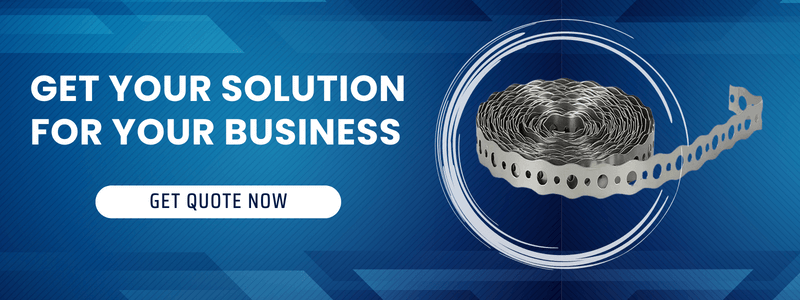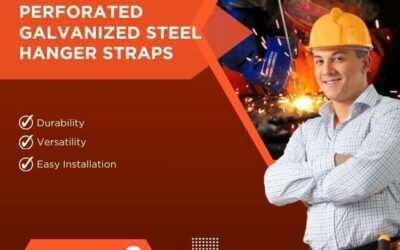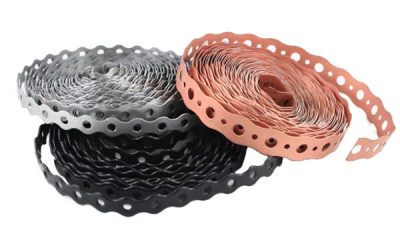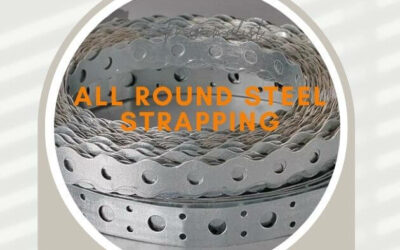Metal hanger straps, also known as metal hanging straps or band-it hangers, are ubiquitous fixtures in many settings. These handy metal fasteners, like galvanized metal duct hanger straps or perforated metal hanger straps, allow us to securely hang, support, and route cables, pipes, ducts, and more. But how well do we really know these metal hanger straps? In this comprehensive guide, we’ll explore everything about these underrated necessities – from proper installation techniques to their strength capacities and applications across industries.
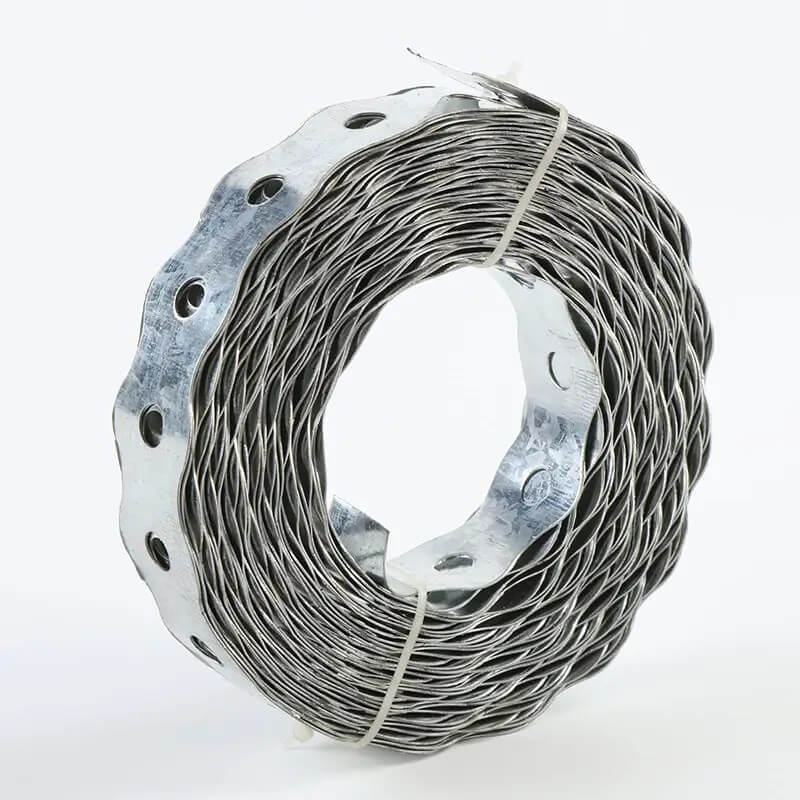
Introduction to Metal Hanger Straps
Metal hanger straps, also known as band-it hangers or perforated straps, are strips of metal with holes punched along their length. They are designed to hang or support cables, conduits, pipes, air ducts, and other components. Galvanized steel, stainless steel, and aluminum are common materials used to make these duct metal hanger straps or sheet metal hanging straps.
These straps provide an adjustable and reliable method to suspend items overhead or route them horizontally along walls and ceilings. They are secured with bolts, screws, or other fasteners through the perforations. Metal hanger straps are valued for their high strength, corrosion resistance, durability, and ease of installation. Many can be found at local hardware stores like Home Depot.
How to Use Metal Hanger Straps
Installing galvanized steel sheet metal hanging straps or metal pipe hanger straps properly is important for safety and security. Here is a step-by-step guide:
Gather the Necessary Materials
- Metal hanger straps
- Screws or bolts to match the strap’s perforations
- Washers
- Drill and drill bits
- Socket wrench or screwdriver
- Tape measure and pencil
Measure and Mark Mounting Locations
Use a tape measure to determine the desired placement for the hanger straps. Mark the locations with a pencil. Follow relevant building codes for overhead clearance requirements.
Cut Metal Hanger Straps to Length
Measure the distance between the mount points and cut the straps to length using tin snips. Wear gloves when cutting to avoid sharp edges.
Drill Holes in Mounting Surfaces
Use a drill and appropriate drill bit to make pilot holes in the ceiling, wall or other mounting surface.
Fasten One End of the Strap
Place one end of the hanger strap over its mounting hole. Insert a screw or bolt with a washer and loosely tighten it with a socket wrench or screwdriver, leaving it loose enough to adjust the positioning.
Level and Position Hanger
Use a level to ensure the hanger strap is positioned evenly. Adjust as needed before fully tightening the first screw or bolt.
Fasten the Other End
On the opposite mounting point, insert a screw or bolt with washer through the hanger strap hole and into the wall or ceiling. Tighten fully to secure that end.
Verify Security
Tug on the metal hanger strap to verify it is firmly fixed in place at both ends. The mounted component can now be hung from the strap.
Tips for Proper Installation
- Use strap widths suitable for the weight load. Wider straps hold more.
- Ensure screws or bolts are long enough for secure fastening.
- Position screws/bolts through the center of strap holes.
- Use washers to prevent pull-through.
- Mount overhead straps into wood joists, studs or masonry, not just drywall.
- Don’t exceed the recommended load capacity.
The Incredible Flexibility of Metal Hanger Straps
One of the handiest features of these metal straps is their flexibility. The thin strip design allows for bending, twisting, and manipulating the straps during installation. This flexibility makes positioning and leveling the hangers much easier. It also allows routing around obstacles.
Bending and Shaping
Metal hanger straps can be bent by hand or using pliers into various shapes and angles to fit specific needs. For example, 90-degree bends can be made to fit conduits into corners. Custom bends and shapes are possible.
Twisting and Turning
The thin metal of the straps enables twisting them around objects. Straps can be twisted to wrap around corners, pipes, beams, and other existing structures for mounting. This allows hangers to be secured in places where direct fastening is difficult.
Snaking Around Obstacles
By selectively bending and twisting, hanger straps can be snaked around obstacles like ducts, cables, and pipes. This allows installers to strategically route the hangers to perfect mounting points.
Case Study: Flexible Data Cable Supports
A data center needed to suspend overhead cable trays holding fiber optic and networking cables. But there were existing conduits, ducts, and pipes obstructing the ideal paths for running the cable tray hangers. By flexibly bending and twisting metal hanger straps in strategic spots, installers were able to snake around all obstacles to optimally position the hangers.
Can Metal Hanger Straps Bend? Exploring Bending Capacity
A common question is whether these metal straps can be bent repeatedly or over-bent. The bending ability depends on the material and properties of the strap. Here are some key considerations:
Ductile vs Brittle Metals
Ductile metals like steel can bend without breaking. More brittle metals like aluminum have less bendability before cracking. Mild steel straps are quite flexible.
Thickness of the Strap
Thinner strap gauges bend more easily. Thicker, heavy-duty straps are more rigid and harder to bend without specialized equipment. Standard straps are moderately flexible.
Width of the Strap
Wider straps are less flexible and bendable than narrower straps of the same gauge. A 1-inch wide strap bends more easily than a 2-inch strap.
Bend Radius
Hanger straps should not be bent tighter than the minimum recommended bend radius. Going below this radius risks material failure.
Bend Direction Matters
Bending the strap perpendicular to the perforations strains the holes less than bending parallel to the holes. Perpendicular bending is preferred.
Real-World Bending Example
A 1-inch wide, 16 gauge steel hanger strap can typically be bent by hand in a bend radius down to approximately 1 inch. Pre-bending straps facilitates installations in tight spaces. But over-bending risks fracturing the metal.
Determining the Weight-Bearing Load Capacity
One of the top considerations when selecting these metal straps is determining the right product for the intended weight load. Several factors influence the load capacity.
Hanger Strap Material
The material’s strength determines the maximum load. Galvanized steel supports more than aluminum. Stainless steel offers high strength.
Hanger Strap Dimensions
Wider, thicker straps hold more weight than narrower, thinner versions. A 1-inch strap holds less than a 2-inch strap.
Orientation of the Load
Hangers support more weight when loaded in tension rather than shear or flexion. Proper orientation maximizes capacity.
Installation Points and Method
More fastener points distribute weight better. Bolting into wood joists holds better than drywall anchors.
Safety Factors
Experts recommend at least a 5:1 safety factor for the rated capacity as a minimum. Higher safety factors are advisable.
Calculating the Working Load
Consider the load orientation, number of fasteners, and materials in the proposed installation and apply safety factors to arrive at the working load limit. Select a hanger rated for this capacity.
Case Study: Heavy Air Conditioning Units
A hospital needed to suspend multiple large commercial AC units weighing up to 500 pounds each from the ceiling. By utilizing 2-inch wide, 10 gauge galvanized steel hangers, with 4-point bolting into wood joists at a 10:1 safety factor, the hangers were rated to safely support the 500-pound working load.
Testing and Standards for Metal Hanger Straps
Reputable metal hanger strap manufacturers test their products thoroughly and comply with applicable standards. This validates strength, safety and performance.
Industry Standards
ASTM A653 specifies minimum mechanical properties and coatings for steel straps. ASTM A1001 governs the technical requirements for installing hangers.
Laboratory Testing
Straps are tested under controlled lab conditions for tensile strength, fatigue resistance, corrosion resistance, and effects of aging.
Load Testing
To measure real-world performance, straps are load tested by suspending calibrated weights from samples until failure occurs.
Quality Control Testing
Routine tests during manufacturing assess coating thickness, hole size, corrosion resistance and other parameters on each batch.
Code Compliance
Local building codes often regulate the performance needs for hangers. Reputable suppliers comply with pertinent codes.
Certifications
Quality straps are certified to various standards like ASME and Underwriters Laboratories (UL) after passing rigorous regulatory tests.
The Many Applications of Metal Hanger Straps
Metal hanger straps provide a versatile, economical solution for supporting components across numerous industries. Here are some of the many applications:
Construction
Hanger straps are ubiquitous in construction for hanging ducts, pipes, conduits, cables and more in commercial and residential buildings. Their flexibility eases installation.
Plumbing
Plumbers rely on hanger straps for suspending water, drain, gas and other types of pipes from floor joists and rafters. Custom bends navigate obstacles.
HVAC
HVAC contractors use hangers to support ductwork, refrigerant lines and other mechanical components overhead and along walls. Straps distribute the load.
Electrical
Electricians use straps to securely route electrical conduits, busways, cables and wiring throughout buildings. Their strength supports heavy loads.
Industrial
Plants utilize metal hanger straps for pipework, conduits, valves, instrumentation, ventilation and more. Durability handles vibration and heat.
Telecom
Data centers and IT rooms use straps to rack-mount or overhead-mount server racks, cable trays, junction boxes and other telecom equipment.
Marine/Offshore
On ships and oil rigs, metal straps mount pipes and ventilation ducts securely to withstand salt air and wave forces in the harsh ocean environment.
Automotive
Dealerships and garages employ hangers for hoists, exhaust extraction arms, air compressor lines, and other shop equipment.
As we can see, metal hanger straps serve endless purposes across many sectors and are a versatile fastening solution.
How Strong Are Metal Hanger Straps?
To select suitable metal hanger straps, it is important to understand their strength limits and load-bearing capacities. This depends on the material and dimensions.
Tensile Strength of Materials
The tensile strength of steel is around 50,000 psi. Stainless steel can exceed 100,000 psi. Aluminum has a tensile strength of approximately 45,000 psi.
Weight Capacities
A 1″ wide, 16 gauge galvanized steel hanger strap has an approximate weight capacity of 500 lbs when loaded axially. Heavier 10 gauge can hold around 1000 lbs.
Testing Max Loads
Hanger straps are load tested in laboratories until failure to determine max load capacities. Safety factors are then applied.
Effects of Dynamic Forces
Vibration and shock loads must be considered. Dynamic forces decrease capacity versus static loads.
Orientation Matters
A metal strap lying flat on edge bears less load than one hanging vertically. Proper orientation maximizes strength.
Increase Capacity
Using wider, thicker straps, multiple straps, and more mounting points boosts the weight capacity. But a 5:1 safety factor is prudent.
While metal hangers appear slender, they are engineered to be surprisingly strong when used properly. But exceeding limits can lead to failure, so verify capacities.
Factors Affecting Metal Hanger Strap Performance
Although metal hanger straps are highly durable, achieving maximum service life requires managing key factors influencing performance:
Corrosion Resistance
Straps should have a corrosion-resistant finish like galvanizing or stainless steel where humidity or chemicals exist.
Ultraviolet Light Effects
UV rays can degrade plastics and coatings on metal over time. Avoid direct sunlight exposure when possible.
Temperature Extremes
Very high or low service temperatures weaken hangers over time. Use straps rated for the max/min service temps.
Environmental Contaminants
Corrosive chemicals, oils, and solvents can attack metal. Choose compatible materials.
Vibration Forces
Constant vibration strains metal to failure prematurely. Use thicker straps and vibration isolators to mitigate effects.
Water Exposure
Standing water accelerates corrosion on steel straps. Position straps to avoid pooling moisture.
Mechanical Damage
Cables or debris rubbing against hangers slowly erodes their strength. Provide clearance.
By selecting suitable metal hanger straps for the service environment and protecting against deterioration, optimal strap longevity and performance can be maintained.
Frequently Asked Questions
What materials are commonly used for making metal hanger straps?
Galvanized steel, stainless steel, and aluminum are typical. Galvanized steel is economical. Stainless provides maximum corrosion resistance. Aluminum is lightweight.
Can I use metal hanger straps outdoors?
Yes, but galvanized or stainless steel is recommended for outdoor use to resist corrosion. UV-resistant coatings help. Protect straps from standing moisture.
How do I choose the right size of metal hanger strap for my project?
Consider the load weight and orientation. Compare to the manufacturer’s listed capacities for each strap width and thickness to select an adequate rating.
Are there any safety guidelines for installing heavy items with metal hanger straps?
OSHA recommends a minimum safety factor of 5 for any hanger strap system. Periodically inspect for corrosion damage. Fasten straps at least every 4 ft for horizontal runs.
What is the typical lifespan of metal hanger straps?
Properly installed indoor galvanized steel hangers have an estimated service life of 20-30 years. Stainless steel lasts indefinitely. Outdoor/corrosive environments shorten life expectancy.
Can metal hanger straps be used for seismic bracing?
Metal strapping can be used for some seismic restraints per code requirements. Ensure the strap type meets the specific seismic rating standards.
How do temperature variations affect the performance of metal hanger straps?
Low temps slightly increase material strength but reduce ductility. High temps decrease yield strength. Use straps rated for max/min service temps.
Are there alternatives to metal hanger straps?
Non-metallic options include heavy nylon and fiberglass straps. But these have lower strength and degrade faster than metal.
Can I paint metal hanger straps to match my decor?
Yes, metal hangers can be spray painted. But paint could flake over time. Use high-quality enamel spray paint suitable for metal surfaces.
What maintenance is required for metal hanger straps?
Periodically inspect for corrosion, damage, and loose fasteners. Replace compromised straps immediately. Maintain protective coatings.
Conclusion
Metal hanger straps may seem mundane, but they play a remarkably helpful role across many industries. Understanding how to properly install these straps, leverage their flexibility, determine their weight capacities, and select suitable types for long-term use empowers us to utilize them effectively. Whether you’re dangling ductwork, fastening conduits, or bracing racks, this ubiquitous product now has no secrets. With this comprehensive knowledge, you can take full advantage of metal hanger straps’ capabilities for your projects.
Perforated Metal Hanger Straps: Installation, Benefits, and Maintenance
Are you tired of dealing with sagging ductwork or unsupported pipes in your home or commercial building? Proper support is crucial for maintaining the integrity and efficiency of your HVAC and plumbing systems. That's where perforated metal hanger straps come into...
Galvanized Steel Strapping vs Stainless Steel Strapping: A Comprehensive Comparison
Introduction When it comes to securing and bundling materials, steel strapping is a popular choice due to its strength, durability, and versatility. However, not all steel strapping is created equal. Two of the most widely used options are galvanized steel strapping...
How To Install All Round Steel Strapping?
If you're in the construction or plumbing industry, you know that hanging pipes securely is crucial for a successful installation. One of the most reliable methods for supporting pipes is using all round steel strapping, also known as banding. This versatile material...

Justin Wong
Hi, I’m Justin, the technical engineer of Jiangmen Masters. We’ve been running a factory in China that makes metal hanger strap for 16 years now, and the purpose of this article is to share the knowledge related to metal hanger strap from a Chinese supplier’s perspective.

